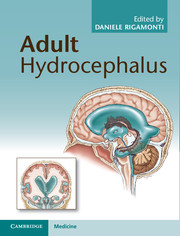Crossref Citations
This Book has been
cited by the following publications. This list is generated based on data provided by Crossref.
SOSVOROVA, L.
MOHAPL, M.
VCELAK, J.
HILL, M.
VITKU, J.
and
HAMPL, R.
2015.
The Impact of Selected Cytokines in the Follow-Up of Normal Pressure Hydrocephalus.
Physiological Research,
p.
S283.
SOSVOROVA, L.
MOHAPL, M.
HILL, M.
STARKA, L.
BICIKOVA, M.
VITKU, J.
KANCEVA, R.
BESTAK, J.
and
HAMPL, R.
2015.
Steroid Hormones and Homocysteine in the Outcome of Patients With Normal Pressure Hydrocephalus.
Physiological Research,
p.
S227.
Gehlen, Manuel
Kurtcuoglu, Vartan
and
Schmid Daners, Marianne
2017.
Is posture-related craniospinal compliance shift caused by jugular vein collapse? A theoretical analysis.
Fluids and Barriers of the CNS,
Vol. 14,
Issue. 1,
Juhler, Marianne
2020.
Role of the Choroid Plexus in Health and Disease.
p.
271.
Niermeyer, Madison
Gaudet, Chad
Malloy, Paul
Piryatinsky, Irene
Salloway, Stephen
Klinge, Petra
and
Lee, Athene
2020.
Frontal Behavior Syndromes in Idiopathic Normal Pressure Hydrocephalus as a Function of Alzheimer’s Disease Biomarker Status.
Journal of the International Neuropsychological Society,
Vol. 26,
Issue. 9,
p.
883.
Skalický, Petr
Mládek, Arnošt
Vlasák, Aleš
De Lacy, Patricia
Beneš, Vladimír
and
Bradáč, Ondřej
2020.
Normal pressure hydrocephalus—an overview of pathophysiological mechanisms and diagnostic procedures.
Neurosurgical Review,
Vol. 43,
Issue. 6,
p.
1451.
Shevchenko, K. V.
Shimanskiy, V. N.
Tanyashin, S. V.
Poshataev, V. K.
Karnaukhov, V. V.
Strunina, Yu. V.
Solozhentseva, K. D.
Pronin, I. N.
Gabrielyan, L. R.
and
Kugushev, I. O.
2023.
Neuroradiological characteristics of hydrocephalus due to idiopathic extraventricular CSF pathways obstruction.
Vestnik nevrologii, psihiatrii i nejrohirurgii (Bulletin of Neurology, Psychiatry and Neurosurgery),
p.
1051.
Shevchenko, K. V.
Shimanskiy, V. N.
Tanyashin, S. V.
Kolycheva, M. V.
Poshataev, V. K.
Karnaukhov, V. V.
Solozhentseva, K. D.
Pronin, I. N.
Strunina, Yu. V.
Gabrielyan, L. R.
and
Kugushev, I. O.
2023.
Clinical picture of hydrocephalus due to extraventricular cisternal CSF pathways obstruction.
Vestnik nevrologii, psihiatrii i nejrohirurgii (Bulletin of Neurology, Psychiatry and Neurosurgery),
p.
944.
Flürenbrock, Fabian
Rosalia, Luca
Podgoršak, Anthony
Sapozhnikov, Katherina
Trimmel, Nina Eva
Weisskopf, Miriam
Oertel, Markus Florian
Roche, Ellen
Zeilinger, Melanie N.
Korn, Leonie
and
Daners, Marianne Schmid
2024.
A Soft Robotic Actuator System for In Vivo Modeling of Normal Pressure Hydrocephalus.
IEEE Transactions on Biomedical Engineering,
Vol. 71,
Issue. 3,
p.
998.
Shevchenko, K. V.
Shimanskiy, V. N.
Tanyashin, S. V.
Poshataev, V. K.
Karnaukhov, V. V.
Solozhentseva, K. D.
Pronin, I. N.
Strunina, Yu. V.
Gabrielyan, L. R.
and
Kugushev, I. O.
2024.
Endoscopic treatment of patients with idiopathic hydrocephalus with extraventricular cisternal obstruction of the cerebrospinal tract.
Vestnik nevrologii, psihiatrii i nejrohirurgii (Bulletin of Neurology, Psychiatry and Neurosurgery),
p.
42.
Fang, Xuhao
Xu, Xinxin
Liu, Chunyan
Li, Shihong
Deng, Yao
Tang, Feng
Zhang, Li
Xing, Yan
Mao, Renling
and
Hu, Jin
2025.
Prevalence of idiopathic normal pressure hydrocephalus in older adult population in Shanghai, China: A population‐based observational study.
Alzheimer's & Dementia,
Vol. 21,
Issue. 2,



